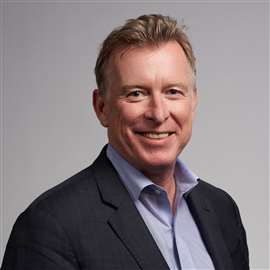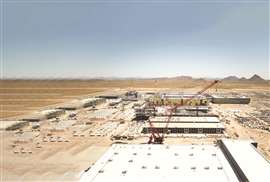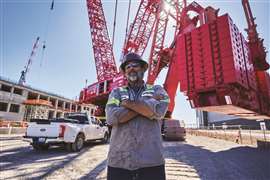Paul McDonnell: ‘It truly feels like an unprecedented time in the market for crane rental’
28 November 2023
Paul McDonnell has zeroed in on strategies that are making a difference at Maxim Crane Works.
Two years ago, Paul McDonnell was named CEO of Maxim Crane Works, the largest crane rental company in North America. His appointment was a signal that new strategies were ahead for Maxim.
A veteran of the specialty equipment industry, McDonnell started out as an entrepreneur with D&E Steel Plate Rentals, which operated in the underground construction, trench safety equipment and supplies space. It was acquired by United Rentals in 1999, and McDonnell stayed on, spending the next 20 years progressing through the rental company giant and ultimately influencing significant change.
 Paul McDonnell, CEO, Maxim Crane Works
Paul McDonnell, CEO, Maxim Crane Works
“I helped to build out the specialty rental segment, which included a portfolio of equipment and services, including fluid solutions, trench safety, power and HVAC, industrial tools and onsite services,” he said of his role as executive vice president and chief commercial officer.
When the opportunity to lead Maxim Crane was presented to him, he was intrigued.
“I found myself excited to have the chance to lead the largest coast-to-coast crane rental company in North America,” he said. “Cranes were the next step in the specialty rental category, so coming to Maxim offered a new and exciting challenge.”
New concepts
In his two years at the helm of Maxim, McDonnell has elevated Maxim’s visibility in the crane realm. He attends top crane industry events, and Maxim’s marketing and digital presence has experienced a renaissance.
McDonnell also has initiated concepts that are relatively new to the crane rental sector. “I think the crane sector can take a step forward relative to other industries and leverage benchmarking, data and analytics to help capitalize on the long-term demand driven by the unprecedented infrastructure and industrial manufacturing investments,” he said. “I worked with Rouse Analytics at United Rentals to develop general and specialty rental industry benchmarks. Rouse’s transformational impact on the industry enabled rental companies to measure their people’s and assets’ performance more effectively, resulting in improved profitability.”
He said that Rouse is making progress in the crane space, and the more information available to Rouse for benchmarking, the better the overall crane sector will perform.
I think you will be interested in McDonnell’s answers to our questions. He has changed the way Maxim does business, and the proof is in the pudding – the company is expecting to post its best year ever in 2023.
You were named CEO of Maxim in December 2021. How do you characterize the company two years later?
It has been a transformational 24 months at Maxim Crane. When I started, we laid out a straightforward strategy focusing on safety, investing in our people, profitable growth, fully integrating the company and becoming “One Maxim” across the country, and aligning our fleet strategy with our customer strategy to better meet the needs of our customers in the industries and geographies they serve.
Safety is a core value for Maxim. It is in our DNA. And it is the highest priority of every employee, every single day. Making sure that employees and customers go home safely to their families is non-negotiable. We worked hard to improve our already strong safety record, resulting in positive momentum in our safety metrics.
One of my favorite areas of change has been our organizational capabilities and, more specifically, investing in our people. There is no doubt, in my humble opinion, that Maxim has incredible talent and expertise in the industry, and we wanted to foster entrepreneurial freedom within our branch network. To a large degree, we promoted from within, helping employees develop new skills to meet the needs of the business, and we created new pathways for professional development in the industry. As we look forward, we want to continue enriching our employees’ lives and empower them to grow professionally. We are on the right path to building a robust employee development program.
We remain focused on profitable growth from a financial performance perspective. When I joined Maxim, this meant moving beyond the traditional unit volume metrics and required us to dig deeper into the business and identify the opportunities to grow margin while investing for future growth. The team’s hard work has shown up in spades, as we have delivered record financial performance in the first three quarters of 2023. We are on track to have the best financial year in the company’s history.
Over the years, we have acquired some fantastic companies. When I arrived, we had an opportunity to better integrate the legacy companies we acquired and bring all our branches under a “One Maxim” umbrella to begin unlocking the benefits of scale. Further, we invested in the brand in 2023 and elevated Maxim under the new tagline, “Rise With Us.” We see this new tagline and branding as an invitation to customers, employees, prospective employees and vendors to help us elevate the business and each other while achieving professional and financial goals.
We established an operational excellence department that standardizes and brings consistency to branch operations nationwide. Our approach to implementing operational excellence was through a proven, effective and long-standing program called 5S. 5S, which stands for Sort, Set in Order, Shine, Standardize, Sustain, has been adopted in many industries and has been proven to help companies create safer, organized and more efficient workplaces.
Finally, to drive profitable growth, we knew we had to focus on our fleet and align our assets to meet the demand of our customers in three key verticals: building, industrial and infrastructure. Our aging fleet needed a refresh, so we strengthened our organizational capability by establishing a new fleet department. We began selling off older assets to fund the purchase of a new crane and support fleet, which we’ve been doing for about a year and a half. Last year was a record year for capital investment in the fleet, as is 2023, resulting in more than 180 new cranes and 444 new support units added to our fleet in the last 24 months.
 In Phoenix, Maxim cranes are helping build one of the most significant investments in semiconductor manufacturing on two jobsites, including using its flagship crawler crane, the Manitowoc 31000.
In Phoenix, Maxim cranes are helping build one of the most significant investments in semiconductor manufacturing on two jobsites, including using its flagship crawler crane, the Manitowoc 31000.
What were your short-term goals?
Short-term, we focused on five key areas: safety, profitable growth, operational excellence, commercial excellence and employee development. Maxim has always had a strong safety record, and we looked to continue optimizing our safety metrics to ensure our employees and customers went home safely to their families every day. We doubled down on the things that were working and made new investments. For example, we partnered with Samsara, a leading fleet telematics provider, to outfit our entire fleet with their innovative tools, which are positively impacting our safety and environmental metrics.
Profitable growth was also a high priority. We focused on identifying opportunities to improve margin, whether that was better-managing maintenance costs through our fleet refresh, growth opportunities within our strategic and national customer segments or improving safety; we took a deep dive into the business to build a sustainable plan of profitable growth, resulting in the record financial results we’ve seen in 2023.
Establishing an operational excellence department that standardizes and brings consistency to branch operations nationwide was also a short-term goal. By introducing the 5S methodology, we’ve created safer, better organized and more efficient workplaces.
To align with the customer strategy, we also had to ensure our sales organization and fleet strategy aligned to meet our customers in the industries and geographies they serve. We established the fleet team and immediately began investing in the crane and support fleet. We understood that we needed a diverse fleet of “fungible” assets, allowing us to be more versatile as we deploy the right crane in the right place at the right time. Pairing our expert in-house engineers with these more versatile applications allows us to be a one-stop shop and provide more creative engineering solutions.
What about the long-term?
Over the long term, we will continue to transform Maxim through more integration across the network to unlock the benefits of scale. We aim to influence change in the sector through organic growth and additional strategic M&A.
Historically, Maxim’s growth has been through an aggressive merger and acquisition strategy. Do you anticipate future M&A activity?
We constantly evaluate growth opportunities, including organic and M&A activity. When considering a strategic acquisition, we ask ourselves: Is this deal financially attractive? Does this acquisition align with our customer strategy? Culturally, is the acquisition a good match? Through this filter, we start to consider if a deal makes sense.
How do you characterize the current market for crane rental in the U.S.?
It truly feels like an unprecedented time in the market for crane rental, as we are tracking broad-based growth across our key verticals of infrastructure and industrial manufacturing through 2027. Driven by significant investment from the private sector and federal expenditures such as the CHIPS Act and the Investment & Jobs Act, the five-year projection for construction demand, specifically crane rental, is strong.
Are some markets more robust than others?
We see substantial opportunities for growth across the verticals we support. In the mid-term, we see growth in infrastructure and industrial manufacturing investments, including mega-projects in the semiconductor and battery space. In my 30 years in the industry, I’ve never seen the incremental investments we see in our backlog. The new mega-project volume is off the charts, and we believe we are well-positioned to serve customers on those projects. In Phoenix, for example, we are supporting one of the most significant investments in semiconductor manufacturing on two jobsites, including using our flagship crawler crane, the Manitowoc 31000, to meet the unique requirements of a project with that size and scope.
Like everyone, we watch how inflation, supply chain and other issues impact different market sectors and more significant projects. Still, we feel confident that we are focused on supporting our customers in the industries they serve.
How do you characterize the used crane market?
We think the stars have aligned for us in the used equipment market. As we all continue to experience lingering issues with the supply chain, we see the same issues driving the used equipment market. Used asset values are up, which aligns nicely with our plan to sell and reinvest in new cranes and support fleet assets. We believe we have one of the largest inventories of used cranes and support equipment in North America, if not the world.
In support of our used equipment sales strategy, we launched a new digital platform in 2022 called Maxim Marketplace, our exclusive online marketplace for used equipment sales. This robust tool is an extension of MaximCrane.com and is a social sales digital platform designed to connect the Maxim brand and used equipment sales team members with our target customers. We believe it is an excellent time to introduce used equipment sales as a line of business at Maxim Crane.
While you have been in the equipment industry for most of your professional life, the crane sector is a different animal. After two years, what has been your experience?
The people in the crane industry are incredible. It’s a close-knit community, and I felt welcome from day one. Despite being in the specialty equipment rental business for more than 25 years, I felt like I was coming into a new, exclusive group of professionals with a ton of passion for the crane industry, the machines and each other. I am proud to be a part of this tight-knit industry.
How do you envision Maxim in 5, 10 or even 20 years from now?
Every action we take today transforms Maxim, and I believe can help influence positive change in the crane industry. As we move forward, I see Maxim becoming a larger company. I see it being more profitable. It will have one of the largest and freshest fleets in the industry. It will set the standards for industry safety. But most of all, it will be a place where our people are incredibly proud to work, and people want to come and do their career-best work. As our new tagline suggests, we invite customers, employees and the industry to “Rise With Us” and participate in this transformational journey.
In this particular market, many crane rental companies have been addressing fleet right-sizing. What has the current market meant for Maxim?
When we talk about our fleet strategy, we do not see it as rightsizing. Instead, we see it as a strategic and thoughtful approach to best position our fleet with the industries and geographies our customers support.
Essentially, we know the availability of the right crane in the right place at the right time is crucial for our customers, and we are positioning our fleet to do just that. This involves selling off older units to purchase newer, more diverse, and fungible assets and investing significant capital into the crane and support fleet. Ultimately, our approach to a diversified fleet allows us to reduce volatility and cyclicality in the business.
How did your career/experience at United Rental help prepare you for this role? Was it an easy transition into cranes?
The crane industry certainly has nuances compared to the general equipment rental sector, though it is closer to the specialty rental business I oversaw at United Rentals. Like specialty rentals, safety, productivity, and providing complex engineering solutions with high levels of expertise and intellectual capital are critical in the crane industry. Cranes also have similar requirements from the customer compared to specialty rentals, ensuring the customers get the right lifting solution when and where they need it.
While the crane industry is similar to specialty rental, the scale of the jobs, logistics and labor in the crane industry is impressive. With our fleet lifting capacity topping 895,000 tons, including one of only two Manitowoc 31000 crawler cranes worldwide, a marvel in and of itself, I was blown away by the capabilities of our fleet. Our massive transportation fleet has over 3,800 tons of heavy haul capacity, 640 tractors, and nearly 2,000 trailers. With bare and operated and maintained rental options, end-to-end logistics, in-house engineering, a diverse fleet of machines, and the expertise we can provide, we are a one-stop shop for lifting solutions for our customers.
At Maxim, building, infrastructure, and industrial are key industries for us, which also overlap with the equipment rental sector. As a result, Maxim is working with many of the same customers, including large, national, and strategic accounts. So, I’m familiar with those customer dynamics.
Like cranes, the specialty products I worked with at United needed to support the critical functions of the jobsite. It is about delivering a safe product with the right expertise, consistent uptime, and ongoing productivity on the job site. We also operate in the same customer industries and large, national, and strategic accounts we focused on at United Rentals. I am familiar with the longer sales cycles and the importance of customer relationships in the industry.
The equipment and the people who work with the equipment every day are highly specialized, which puts the focus even more on our ability to build strong relationships with customers to help inform our processes and manage this type of equipment. Expertise is also essential; having all support services, such as engineering and transportation, under one roof is a great advantage for us.
Ultimately, my experience at United showed me that when you invest in great talent, optimize safety, focus on profitable growth, and increase productivity, the sky is the limit. The combination of operational, commercial, and professional excellence has translated into record financial results, and we are continuing to grow these attributes at Maxim.
Team development
Maxim CEO Paul McDonnell has focused much of his time on “getting the right people in the right seats across the company.”
 Getting the Maxim leadership team in place has been a priority over the past two years.
Getting the Maxim leadership team in place has been a priority over the past two years.
This included promoting more than 70 employees, elevating critical leadership to new strategic positions in the company and recruiting new team members from the outside to meet specific needs, he said.
“We have established seven regional vice presidents supported by six regional sales and marketing directors, all sourced internally. We established a new fleet management team headed by long-time Maxim leader Larry Lis. We reorganized our crawler division, again by promoting within, appointing Mike Bernardy to vice president. We established Dennis Collins as the operational excellence leader, who heads up the deployment of the 5S methodology across our branches. We elevated our digital and marketing presence by promoting Nick Oldfield to vice president of digital and marketing.”
McDonnell looked outside for critical leadership roles, naming Rebecca Bolchalk as chief human resources officer and Dave Reed as vice president of information technology. More recently, Maxim realigned its tower division under the leadership of Matt Hyden.
STAY CONNECTED


Receive the information you need when you need it through our world-leading magazines, newsletters and daily briefings.



